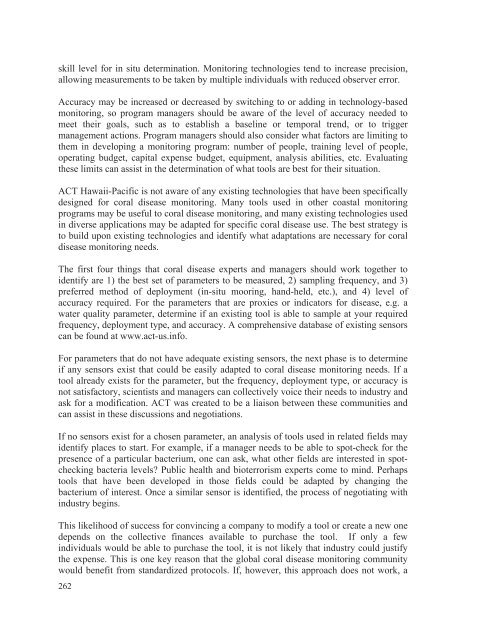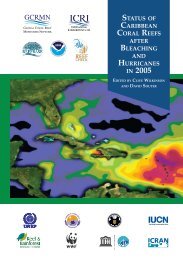Coral Health and Disease in the Pacific: Vision for Action
Coral Health and Disease in the Pacific: Vision for Action
Coral Health and Disease in the Pacific: Vision for Action
You also want an ePaper? Increase the reach of your titles
YUMPU automatically turns print PDFs into web optimized ePapers that Google loves.
skill level <strong>for</strong> <strong>in</strong> situ determ<strong>in</strong>ation. Monitor<strong>in</strong>g technologies tend to <strong>in</strong>crease precision,allow<strong>in</strong>g measurements to be taken by multiple <strong>in</strong>dividuals with reduced observer error.Accuracy may be <strong>in</strong>creased or decreased by switch<strong>in</strong>g to or add<strong>in</strong>g <strong>in</strong> technology-basedmonitor<strong>in</strong>g, so program managers should be aware of <strong>the</strong> level of accuracy needed tomeet <strong>the</strong>ir goals, such as to establish a basel<strong>in</strong>e or temporal trend, or to triggermanagement actions. Program managers should also consider what factors are limit<strong>in</strong>g to<strong>the</strong>m <strong>in</strong> develop<strong>in</strong>g a monitor<strong>in</strong>g program: number of people, tra<strong>in</strong><strong>in</strong>g level of people,operat<strong>in</strong>g budget, capital expense budget, equipment, analysis abilities, etc. Evaluat<strong>in</strong>g<strong>the</strong>se limits can assist <strong>in</strong> <strong>the</strong> determ<strong>in</strong>ation of what tools are best <strong>for</strong> <strong>the</strong>ir situation.ACT Hawaii-<strong>Pacific</strong> is not aware of any exist<strong>in</strong>g technologies that have been specificallydesigned <strong>for</strong> coral disease monitor<strong>in</strong>g. Many tools used <strong>in</strong> o<strong>the</strong>r coastal monitor<strong>in</strong>gprograms may be useful to coral disease monitor<strong>in</strong>g, <strong>and</strong> many exist<strong>in</strong>g technologies used<strong>in</strong> diverse applications may be adapted <strong>for</strong> specific coral disease use. The best strategy isto build upon exist<strong>in</strong>g technologies <strong>and</strong> identify what adaptations are necessary <strong>for</strong> coraldisease monitor<strong>in</strong>g needs.The first four th<strong>in</strong>gs that coral disease experts <strong>and</strong> managers should work toge<strong>the</strong>r toidentify are 1) <strong>the</strong> best set of parameters to be measured, 2) sampl<strong>in</strong>g frequency, <strong>and</strong> 3)preferred method of deployment (<strong>in</strong>-situ moor<strong>in</strong>g, h<strong>and</strong>-held, etc.), <strong>and</strong> 4) level ofaccuracy required. For <strong>the</strong> parameters that are proxies or <strong>in</strong>dicators <strong>for</strong> disease, e.g. awater quality parameter, determ<strong>in</strong>e if an exist<strong>in</strong>g tool is able to sample at your requiredfrequency, deployment type, <strong>and</strong> accuracy. A comprehensive database of exist<strong>in</strong>g sensorscan be found at www.act-us.<strong>in</strong>fo.For parameters that do not have adequate exist<strong>in</strong>g sensors, <strong>the</strong> next phase is to determ<strong>in</strong>eif any sensors exist that could be easily adapted to coral disease monitor<strong>in</strong>g needs. If atool already exists <strong>for</strong> <strong>the</strong> parameter, but <strong>the</strong> frequency, deployment type, or accuracy isnot satisfactory, scientists <strong>and</strong> managers can collectively voice <strong>the</strong>ir needs to <strong>in</strong>dustry <strong>and</strong>ask <strong>for</strong> a modification. ACT was created to be a liaison between <strong>the</strong>se communities <strong>and</strong>can assist <strong>in</strong> <strong>the</strong>se discussions <strong>and</strong> negotiations.If no sensors exist <strong>for</strong> a chosen parameter, an analysis of tools used <strong>in</strong> related fields mayidentify places to start. For example, if a manager needs to be able to spot-check <strong>for</strong> <strong>the</strong>presence of a particular bacterium, one can ask, what o<strong>the</strong>r fields are <strong>in</strong>terested <strong>in</strong> spotcheck<strong>in</strong>gbacteria levels? Public health <strong>and</strong> bioterrorism experts come to m<strong>in</strong>d. Perhapstools that have been developed <strong>in</strong> those fields could be adapted by chang<strong>in</strong>g <strong>the</strong>bacterium of <strong>in</strong>terest. Once a similar sensor is identified, <strong>the</strong> process of negotiat<strong>in</strong>g with<strong>in</strong>dustry beg<strong>in</strong>s.This likelihood of success <strong>for</strong> conv<strong>in</strong>c<strong>in</strong>g a company to modify a tool or create a new onedepends on <strong>the</strong> collective f<strong>in</strong>ances available to purchase <strong>the</strong> tool. If only a few<strong>in</strong>dividuals would be able to purchase <strong>the</strong> tool, it is not likely that <strong>in</strong>dustry could justify<strong>the</strong> expense. This is one key reason that <strong>the</strong> global coral disease monitor<strong>in</strong>g communitywould benefit from st<strong>and</strong>ardized protocols. If, however, this approach does not work, a262
















